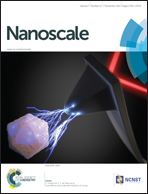Strain-tuned optoelectronic properties of hollow gallium sulphide microspheres†
Abstract
Sulfide semiconductors have attracted considerable attention. The main challenge is to prepare materials with a designable morphology, a controllable band structure and optoelectronic properties. Herein, we report a facile chemical transportation reaction for the synthesis of Ga2S3 microspheres with novel hollow morphologies and partially filled volumes. Even without any extrinsic dopant, photoluminescence (PL) emission wavelength could be facilely tuned from 635 to 665 nm, depending on its intrinsic inhomogeneous strain distribution. Geometric phase analysis (GPA) based on high-resolution transmission electron microscopy (HRTEM) imaging reveals that the strain distribution and the associated PL properties can be accurately controlled by changing the growth temperature gradient, which depends on the distance between the boats used for raw material evaporation and microsphere deposition. The stacking-fault density, lattice distortion degree and strain distribution at the shell interfacial region of the Ga2S3 microspheres could be readily adjusted. Ab initio first-principles calculations confirm that the lowest conductive band (LCB) is dominated by S-3s and Ga-4p states, which shift to the low-energy band as a result of the introduction of tensile strain, well in accordance with the observed PL evolution. Therefore, based on our strain driving strategy, novel guidelines toward the reasonable design of sulfide semiconductors with tunable photoluminescence properties are proposed.


 Please wait while we load your content...
Please wait while we load your content...